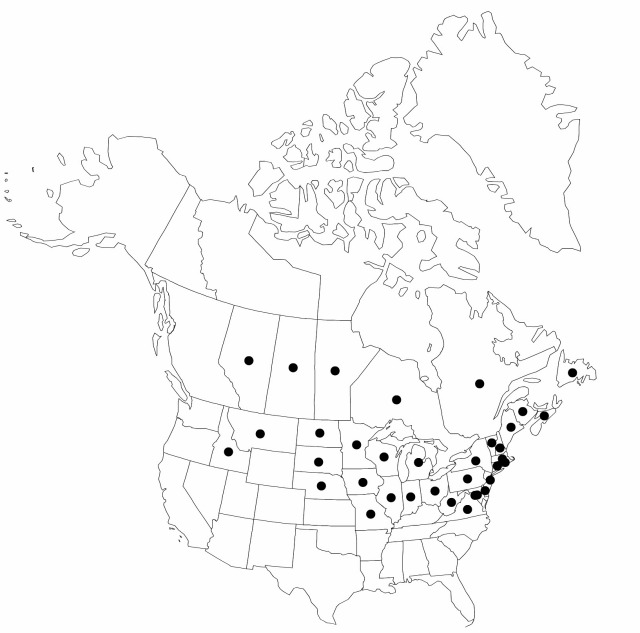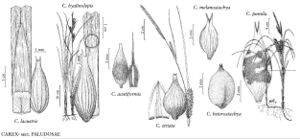Carex lacustris
Sp. Pl. 4(1): 306. 1805.
Plants colonial; rhizomes long-creeping. Culms lateral, coarse, trigonous, 50–135 cm, smooth or somewhat scabrous-angled distally. Leaves: basal sheaths reddish purple, strongly fibrillose, bladeless; longest ligules 13–40 (–56) mm, much longer than wide; blades glaucous to pale green, M-shaped, (5.5–) 8.5–21 mm wide, glabrous. Inflorescences 17–60 cm; proximal 2–4 spikes pistillate, ascending to arching; distal spikes erect; terminal 3–5 (–7) spikes staminate. Pistillate scales lanceolate to ovate, apex obtuse to acuminate, glabrous, awn 0.3–3.5 mm, ± scabrous. Perigynia ascending, usually strongly 14–28-veined, narrowly ovoid to narrowly ellipsoid, (4.5–) 5.2–7.8 × 1.6–2.5 mm, glabrous; beak obscure, 0.5–1.6 mm, bidentulate, teeth straight, 0.2–0.7 (–0.9) mm. 2n = 74.
Phenology: Fruiting May–Jul.
Habitat: Open swamps, wet, open thickets, marsh edges, sedge meadows, fens, shores of streams, ponds and lakes
Elevation: 0–1000 m
Distribution

Alta., Man., N.B., Nfld. and Labr. (Nfld.), N.S., Ont., Que., Sask., Conn., Del., D.C., Idaho, Ill., Ind., Iowa, Maine, Md., Mass., Mich., Minn., Mo., Mont., Nebr., N.H., N.J., N.Y., N.Dak., Ohio, Pa., R.I., S.Dak., Vt., Va., W.Va., Wis.
Discussion
Carex lacustris is abundant and often a dominant of calcareous, north-temperate wetlands. Sometimes extensive stands are seen without fertile culms.
Rare hybrids between Carex lacustris and C. hyalinolepis, C. pellita, C. trichocarpa (P. M. Catling et al. 1989), and C. utriculata are known; the hybrids are sterile and intermediate in morphology and can form extensive clones.
Selected References
None.
Lower Taxa
"lengthofbody" is not declared as a valid unit of measurement for this property."shortened" is not a number.
